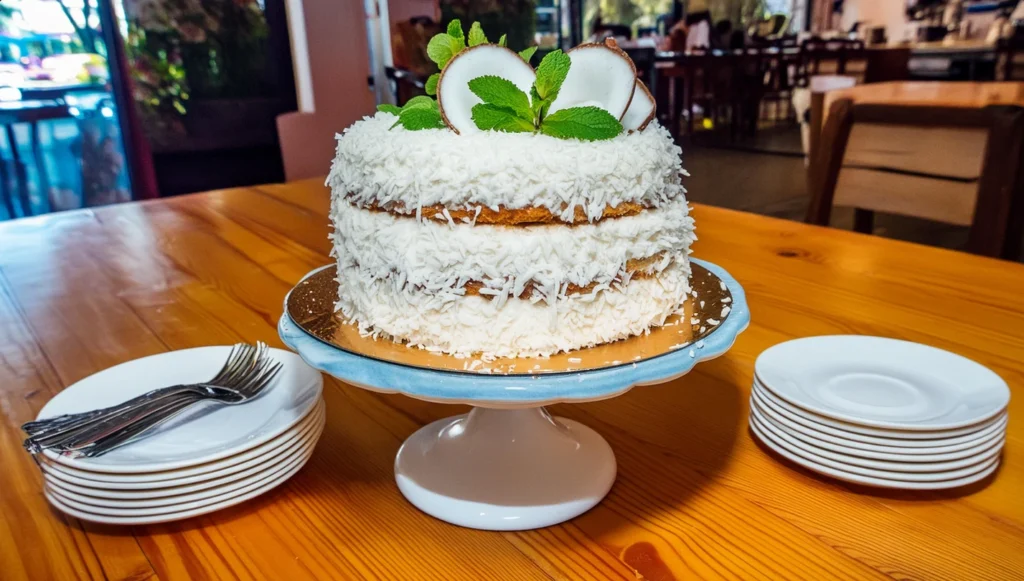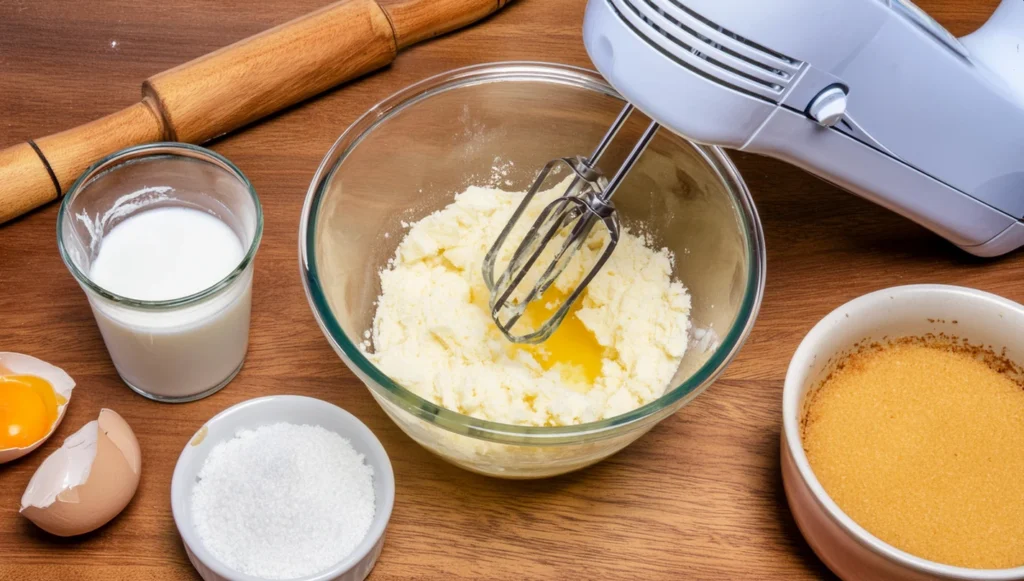
Introduction to Coconut Cake
Coconut cake recipes are a delightful treat that transcends cultures and cuisines, celebrated for their rich flavors and versatile variations. This cake is a staple in holiday feasts, weddings, and casual gatherings, offering a sweet, tropical flavor that captivates dessert lovers everywhere.
Key Ingredients
Coconut cake recipes typically involve a variety of ingredients that contribute to their unique taste and texture:
- Coconut: Comes in several forms:
- Shredded coconut for texture and flavor
- Coconut milk, which adds moisture and enhances the coconut flavor
- Coconut cream for a rich, creamy consistency
- Flour: The choice between all-purpose flour and cake flour can affect the cake’s crumb:
- All-purpose flour makes a denser cake
- Cake flour results in a lighter, fluffier texture
- Fats: Essential for the cake’s moisture and structure:
- Butter for richness
- Oil keeps the cake moist longer
- Coconut oil can be used for an extra coconutty flavor

Basic Coconut Cake Recipe
Here’s a basic recipe to get you started with making coconut cake recipes:
- Ingredients:
- 1 cup of unsalted butter, softened
- 2 cups of sugar
- 4 eggs
- 3 cups of cake flour, sifted
- 1 cup coconut milk
- ½ cup shredded coconut
- 1 teaspoon vanilla extract
- 2 teaspoons baking powder
- ½ teaspoon salt
- Instructions:
- Preheat your oven to 350°F (175°C) and grease and flour two 9-inch cake pans.
- Cream the butter and sugar together until light and fluffy. Add eggs one at a time, beating well after each addition.
- Mix in vanilla extract and coconut milk.
- Combine the dry ingredients separately and gradually add them to the wet ingredients.
- Fold in the shredded coconut and pour the batter into the prepared pans.
- Bake for 25-30 minutes or until a toothpick inserted into the center comes out clean.
- Let the cakes cool before frosting with your choice of coconut buttercream or cream cheese frosting.
For a detailed guide on how to make this cake, and for more inspiration from experienced bakers, visit Imperial Sugar Vintage Cookbooks, a great resource for tried and tested recipes.
Coconut cake recipes require careful attention to detail, particularly when it comes to the mixing and baking stages. Over-mixing the batter can lead to a tough cake, while under-mixing might not incorporate the air needed for a light texture. Always ensure ingredients like butter and eggs are at room temperature to achieve a uniform mixture that bakes evenly.
For those interested in more Coconut dessert recipes, consider exploring The Delights of Coconut Jelly, which offers insights into another variations of coconut desserts.
Advanced Baking Techniques
Mastering coconut cake recipes involves not only precision in measurement but also skill in execution. Here are some advanced techniques to enhance your baking:
- Ingredient Temperatures: Ensure all ingredients are at room temperature unless specified otherwise. This promotes better emulsification and more even baking.
- Mixing Methods:
- Creaming: Properly creaming butter and sugar traps air which helps the cake rise.
- Folding: Incorporate dry ingredients and delicate components like whipped egg whites by folding gently to retain air.
- Baking Tips: Use an oven thermometer to verify your oven’s temperature accuracy. Additionally, rotating the cake halfway through the baking process can help achieve an even bake.

Recipe Variations
Exploring variations of the traditional coconut cake recipe can lead to delightful discoveries. Here are some variations to consider:
- Gluten-Free Coconut Cake:
- Substitute the flour with a gluten-free blend.
- Ensure all other ingredients like baking powder are gluten-free.
- Vegan Coconut Cake:
- Replace eggs with flaxseed meal or prepared egg replacer.
- Use vegan butter and coconut cream instead of dairy products.
- Incorporating Unique Ingredients:
- Cardamom: Adds a warm, spicy flavor that complements coconut.
- Coconut Water: For a lighter, more refreshing flavor, replace milk with coconut water.
Each variation requires adjustments to the basic recipe but can provide a new twist on the classic flavor. For more innovative baking ideas and recipes, explore resources like Sally’s Baking Addiction Coconut Cake, known for its creative and delightful twists on traditional desserts.
Detailed Reviews of Top Recipes
Delving into the specifics, here’s what makes each coconut cake recipe from top culinary sites stand out:
- The Classic Recipe: Known for its straightforward approach and traditional flavor, using butter and all-purpose flour.
- Tropical Twist: Incorporates pineapple juice and rum for a Caribbean flavor.
- The Ultimate Moist Cake: Utilizes sour cream and coconut milk, making it incredibly moist and rich.
By comparing these recipes, bakers can appreciate the impact of small changes in ingredients and techniques on the final product. For example, the introduction of sour cream in some recipes enhances moisture significantly, creating a denser, creamier texture.
Enhancements and Serving
Frosting and Topping Ideas
The choice of frosting and toppings can transform the taste and presentation of your coconut cake recipes. Consider these options:
- Frostings:
- Cream Cheese Frosting: Offers a tangy contrast to the sweet cake.
- Buttercream Frosting: Provides a rich and smooth coating.
- Meringue Frosting: Adds a light, airy texture.
- Toppings:
- Toasted coconut flakes for a crunchy texture.
- Chopped nuts (such as almonds or pecans) for added flavor.
- Edible flowers or fruit slices for decoration.
Serving and Presentation Tips
Presentation plays a crucial role in enhancing the overall appeal of the cake:
- Slicing: Use a sharp, thin-bladed knife, dipping it in hot water between slices for clean cuts.
- Occasions:
- For formal events, consider elegant garnishes like gold leaf or delicate piped designs.
- For casual gatherings, a rustic look with generous sprinkles of coconut and icing sugar works well.
FAQs
Addressing common queries about coconut cake recipes:
- Can I substitute coconut milk for regular milk in the cake recipe?
- Yes, coconut milk can be substituted one-to-one for regular milk to enhance the coconut flavor.
- How do I prevent the cake from being too dry?
- Ensure not to overbake and consider ingredients like sour cream or yogurt to add moisture.
- Can I make the cake in advance?
- Yes, coconut cake recipes typically keep well. The flavors can even enhance after a day. Just ensure it’s covered properly to prevent drying out.
Conclusion
Coconut cake recipes offer a versatile platform for both novice and experienced bakers to experiment and showcase their skills. Whether adapting the recipe to dietary restrictions, trying out different flavors, or perfecting the texture, each iteration can be a learning experience. Embrace the process, and don’t be afraid to innovate and adapt the recipes to suit your taste and preferences.
As you continue to explore the vast world of baking, remember that every recipe, including coconut cake recipes, is just a starting point. The real magic happens when you bring your own creativity and flair to the kitchen. Happy baking, and may your cakes always rise to the occasion!
For additional tips on enhancing other dessert recipes or incorporating unique ingredients into your baking repertoire, don’t hesitate to visit Our Desserts Section, where a plethora of resources awaits to inspire and guide you in your culinary adventures.

Delicious Coconut Cake Recipes to Try at Home
- Total Time: 50 minutes
- Yield: 12 servings 1x
Description
Coconut cake recipes are a delightful treat that transcends cultures and cuisines, celebrated for their rich flavors and versatile variations. This cake is a staple in holiday feasts, weddings, and casual gatherings, offering a sweet, tropical flavor that captivates dessert lovers everywhere.
Ingredients
1 cup unsalted butter, softened
2 cups sugar
4 eggs
3 cups cake flour, sifted
1 cup coconut milk
½ cup shredded coconut
1 teaspoon vanilla extract
2 teaspoons baking powder
½ teaspoon salt
Instructions
Step 1: Preheat the Oven and Prepare Pans
Preheat your oven to 350°F (175°C).
Grease and flour two 9-inch cake pans to prevent sticking.
Step 2: Cream Butter and Sugar
In a large mixing bowl, use an electric mixer to cream the softened butter and sugar together until light and fluffy. This usually takes about 3-4 minutes.
Step 3: Add Eggs and Vanilla
Add eggs one at a time to the creamed butter and sugar, beating well after each addition to incorporate.
Stir in the vanilla extract.
Step 4: Combine Dry Ingredients
In a separate bowl, sift together the cake flour, baking powder, and salt.
Step 5: Mix Dry and Wet Ingredients
Gradually add the dry ingredients to the wet mixture, alternating with coconut milk. Start and end with the dry ingredients to ensure everything is well incorporated. Mix until just combined to avoid overmixing.
Step 6: Add Coconut
Fold in the shredded coconut gently with a spatula to distribute evenly throughout the batter.
Step 7: Pour Batter into Pans
Divide the cake batter evenly between the two prepared cake pans.
Step 8: Bake
Place the pans in the preheated oven and bake for 25-30 minutes, or until a toothpick inserted into the center of the cakes comes out clean.
Step 9: Cool
Remove the cakes from the oven and allow them to cool in the pans for about 10 minutes. Then, turn out the cakes onto a wire rack to cool completely.
Step 10: Frosting (Optional)
Once the cakes are completely cool, you can frost them with your choice of frosting, such as coconut buttercream or cream cheese frosting. Apply a crumb coat first, chill for 30 minutes, then apply the final coat of frosting.
If desired, sprinkle the top with additional toasted shredded coconut or other decorations.
Step 11: Serve
Once frosted, the cake is ready to be sliced and served.
- Prep Time: 20 minutes
- Cook Time: 30 minutes
- Category: DESSERTS
- Method: Baking
- Cuisine: International
Nutrition
- Serving Size: 1 slice
- Calories: 450 kcal
- Sugar: 35g
- Sodium: 220mg
- Fat: 20g
- Saturated Fat: 15g
- Unsaturated Fat: 3g
- Trans Fat: 0g
- Carbohydrates: 60g
- Fiber: 1g
- Protein: 5g
- Cholesterol: 100mg
Keywords: coconut cake recipes, coconut cake ideas, tropical coconut cakes, homemade coconut cakes
